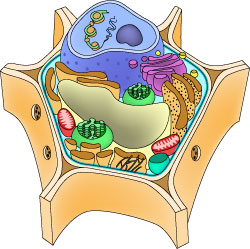Plants And Animal Cells Biography
Source:- Google.com.pk
Article Summary: Looking for a simple explanation of the potentially confusing terms 'diffusion', 'osmosis' and 'tonicity'? Well here it is
What Is Diffusion?
Diffusion is the passive transport of molecules from an area of higher concentration to an area of lower concentration; and, surprisingly, you are very familiar with this process, whether you realize it or not.
When you put on perfume or aftershave, you can't just do it once and stay smelling sweet for the rest of your life (much to the relief of perfumers). The molecules of scent slowly diffuse from the area where you applied them, until so many have departed that you can no longer detect your signature scent.
A less pleasant example is the very recognizable smell of skunk stink. If you are driving down the road towards a dead skunk, the unpleasant smell gets stronger and stronger as your car approaches the skunk. This is because the stinky molecules are more concentrated closer to their skunky source.
What Is Osmosis?
Osmosis is a special kind of diffusion; the diffusion of water molecules across a membrane, typically the membrane of a living cell. The environment surrounding each of our cells may contain small amounts of dissolved substances (solutes) that are equal to, less than, or greater than those found within the cell. The relationship between the concentrations of solutes on either side of the membrane is referred to as tonicity.
How Does Tonicity Relate to Osmosis?
If a cell is in a surrounding environment that's:
isotonic: There is no net movement of water between cell and environment. The concentration of solutes is the same on either side of the membrane.
hypertonic: This term refers to the side of the membrane with a higher concentration of solute.
hypotonic: This term refers to the side of the membrane with a lower concentration of solute.
These terms describing tonicity are dependent on the relationship between the environments on either side of the membrane, and can apply to the environment inside the cell or the environment outside the cell. The key to understanding osmosis and tonicity is to remember that water will always move toward a hypertonic environment!
Osmosis and Animal Cells
The cells of our body normally exist in an isotonic environment. When cells are placed in a hypertonic environment (higher concentration of solutes than the cell), water leaves the cell and the cell becomes shriveled. Conversely, when animal cells are placed in a hypotonic solution (lower concentration of solutes than the cell), water moves into the cell; it swells and may explode.
Diagram of Osmosis in Red Blood Cells
Osmosis and Plant Cells
Plant cells are subjected to osmostic pressure, just as animal cells are. However these cells are surrounded by a strong, rigid cell wall which prevents the cell from taking on too much water and exploding. When plant cells are exposed to water, the water moves into the cells, making them plump (turgid). This is why house plants look healthy and firm when they are watered sufficiently.
Diagram of theEffect of Osmosis on Plant Cells
In contrast, the loss of water by plant cells (plasmolysis) can occur when plants are not sufficiently watered, or are surrounded by a hypertonic environment. When water leaves the plant cell, it is not as plump, although the structure of the cell wall prevents the plasmolyzed cell from losing shape entirely.
Exposure to extremely hypertonic environments can kill a plant, like how your dog creates spots of dead lawn where he pees. The urine is hypertonic to the interior of the cells that make up the blade of grass, and large amounts of water are drawn out of the grass, killing it.
Sources & Helpful Osmosis & Diffusion Links
Campbell, N., Reece, J. and Simon E. (2004) "Essential Biology with Physiology". Pearson Benjamin Cummings.
How Diffusion Works animation and quiz from McGraw-Hill.
The Cell: Passive Transport Diffusion from Wisc-Online.com.
How Osmosis Works animation and quiz from McGraw-Hill.
The Cell: Passive Transport Osmosis from Wisc-Online.com.
Osmosis animation from St. Olaf College.
Plasmolysis animation and quiz from McGraw-Hill.
This is why a nurse can't give someone an IV drip of pure water. The patient's cells would explode. This is also why, if stranded at sea, people are cautioned not to drink the ocean water, no matter how thirsty they may become. Drinking salt water actually robs the body of hydration, because it creates a hypertonic environment in the GI tract, which pulls water out of our cells, dehydrating the body.
Plants And Animal Cells Animal Cell Model Diagram Project Parts Structure Labeled Coloring and Plant Cell Organelles Cake


Plants And Animal Cells Animal Cell Model Diagram Project Parts Structure Labeled Coloring and Plant Cell Organelles Cake


Plants And Animal Cells Animal Cell Model Diagram Project Parts Structure Labeled Coloring and Plant Cell Organelles Cake


Plants And Animal Cells Animal Cell Model Diagram Project Parts Structure Labeled Coloring and Plant Cell Organelles Cake


Plants And Animal Cells Animal Cell Model Diagram Project Parts Structure Labeled Coloring and Plant Cell Organelles Cake


Plants And Animal Cells Animal Cell Model Diagram Project Parts Structure Labeled Coloring and Plant Cell Organelles Cake


Plants And Animal Cells Animal Cell Model Diagram Project Parts Structure Labeled Coloring and Plant Cell Organelles Cake


Plants And Animal Cells Animal Cell Model Diagram Project Parts Structure Labeled Coloring and Plant Cell Organelles Cake


Plants And Animal Cells Animal Cell Model Diagram Project Parts Structure Labeled Coloring and Plant Cell Organelles Cake


Plants And Animal Cells Animal Cell Model Diagram Project Parts Structure Labeled Coloring and Plant Cell Organelles Cake


Plants And Animal Cells Animal Cell Model Diagram Project Parts Structure Labeled Coloring and Plant Cell Organelles Cake
Very Nice Post
ReplyDeleteVery Nice Post
Very Nice Post